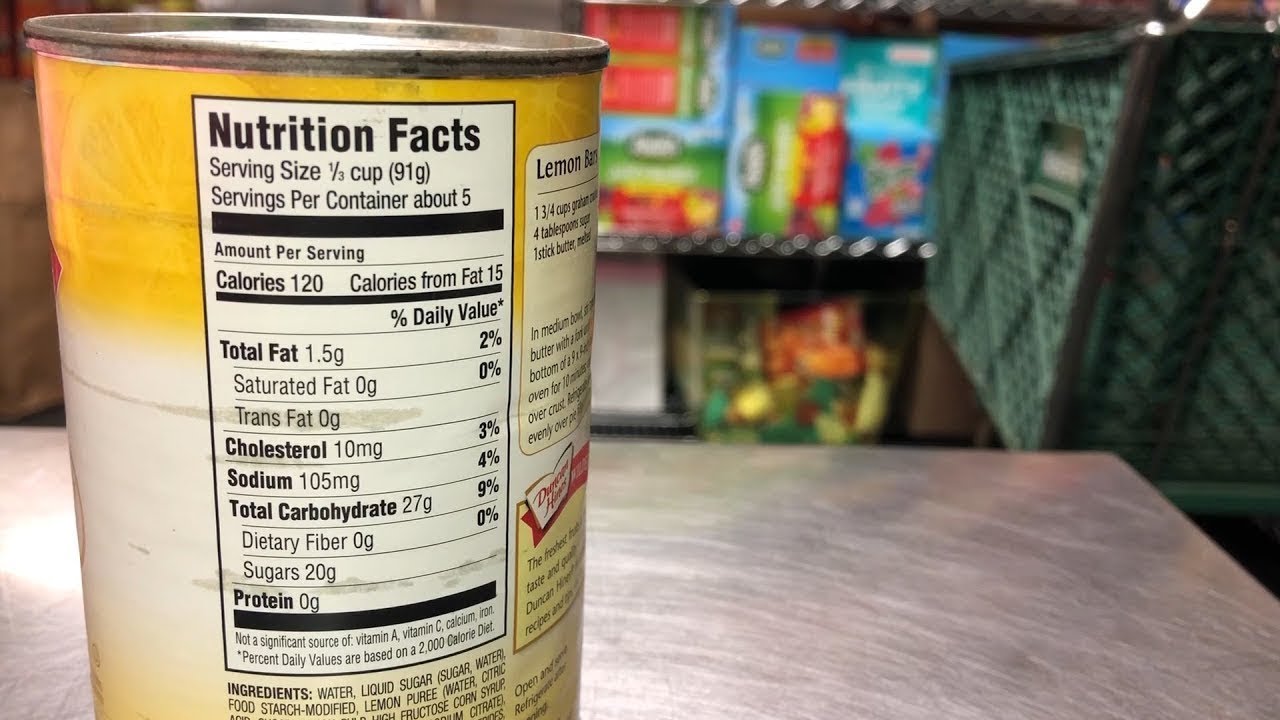Navigating the world of food packaging can be a daunting task, especially when it comes to deciphering nutrition labels. In an age where health and wellness are at the forefront of many people’s minds, understanding these labels not only empowers consumers but also aids in making healthier choices. Whether you’re shopping for groceries or dining out, being aware of what’s inside your food can make a significant difference in your overall well-being.
Nutrition labels

Nutrition labels are designed to provide essential information about the contents of packaged foods. They typically include details on calories, nutrients, and serving sizes, offering insights that help consumers make informed dietary decisions. However, despite their usefulness, many people struggle to interpret these labels effectively.
The Components of a Nutrition Label
Understanding the components of a nutrition label is crucial for anyone looking to make healthier choices. The label generally starts with the serving size, which indicates how much of the product is considered one serving.
When examining the serving size, it is vital to compare it with how much you actually consume. For example, if a bag of chips lists a serving size as 15 chips, but you usually eat half the bag, you’ll need to calculate the nutritional content based on your portion. This basic math can significantly alter your perception of how “healthy” a snack might be.
Following the serving size, calories appear next. This number reflects the energy provided by one serving of the food item. It’s important to consider not just the number of calories but where they come from. Foods high in added sugars and unhealthy fats may have similar calorie counts as whole, nutrient-dense foods like fruits and vegetables.
Next, the label details various nutrients such as fats, carbohydrates, protein, vitamins, and minerals. Each nutrient plays a unique role in our bodies and contributes to our overall health. For instance, increased fiber intake can aid digestion, while excessive saturated fat can increase the risk of heart disease. By taking the time to understand the function of each nutrient, you empower yourself to make better dietary choices.
Daily Values and Percentages
Another significant aspect of nutrition labels is the Daily Value (DV) percentage, which tells you how much a nutrient in a serving contributes to a daily diet. These percentages are based on a standard 2,000-calorie diet, but individual needs may vary significantly.
Diving deeper into the Percent Daily Value (PDV) can serve as a guideline for identifying whether a food is high or low in a particular nutrient. A general rule of thumb is that 5% DV or less is considered low, while 20% DV or more is deemed high. However, it’s essential to assess the entire nutritional profile rather than focusing solely on this percentage.
Being aware of the DV helps you tailor your diet according to your personal health goals, whether you are aiming to increase your calcium intake or reduce sodium consumption. Consequently, when analyzing nutrition labels, remember that context matters. What works for one person may not apply to another, underscoring the importance of individualized dietary choices.
Hidden Ingredients and Additives
Many consumers may overlook the ingredient list that accompanies nutrition labels. Yet, this list can be equally important in evaluating the healthfulness of a food product. Ingredients are listed in descending order by weight, meaning that the first few items are present in the largest quantities.
Keeping an eye out for hidden ingredients—such as artificial preservatives, flavor enhancers, or excessive sugar—is essential for maintaining a healthy diet. For instance, terms like high fructose corn syrup or partially hydrogenated oils may indicate that a product is processed, which could affect its nutritional value adversely.
Moreover, understanding common additives can foster greater awareness about what you’re putting into your body. Many people assume that a product labeled “low-fat” or “sugar-free” is automatically healthy; however, these products often contain fillers or artificial ingredients that can be detrimental to your health.
In conclusion, dissecting nutrition labels involves understanding their components, interpreting daily values, and recognizing hidden ingredients. By grasping these facets, consumers can become equipped to make informed choices about their food options, allowing them to lead healthier lifestyles.
Tips for understanding food packaging and making healthier choices.
Understanding food packaging goes beyond simply reading nutrition labels; it requires a holistic approach that encompasses several aspects of food choices. Here are some insightful tips to keep in mind.
Familiarize Yourself with Common Terminology
The language used on food packaging can often be confusing, with many terms meant to entice consumers rather than inform them. Being familiar with common terminology will equip you with the knowledge needed to see through marketing tactics.
Take note of terms like “natural,” “organic,” and “whole grain.” While these phrases may sound healthy, they do not always guarantee a nutritious product. For example, “natural” does not have a standardized definition in the U.S., meaning products bearing this label may still contain artificial ingredients.
“Organic,” on the other hand, is more straightforward, indicating that at least 95% of the ingredients were produced without synthetic pesticides or fertilizers. Still, it’s crucial to read the whole label, as organic products can still be high in sugar or unhealthy fats.
Additionally, “whole grain” implies that the food contains the entire grain kernel, but some products may substitute refined grains alongside. Always check for the word “whole” before the grain type (like “whole wheat”) to ensure you are getting the nutritional benefits.
By internalizing these terms, you gain power over your food choices and can avoid falling prey to misleading advertising.
Prioritize Whole Foods Over Processed Options
As a rule of thumb, prioritize whole foods whenever possible. Whole foods—like fresh fruits, vegetables, whole grains, legumes, and unprocessed proteins—are typically higher in essential nutrients and lower in unhealthy additives and sugars.
When comparing two products, opt for those with shorter ingredient lists filled with recognizable items. If the label resembles a chemistry experiment, it’s probably best left on the shelf.
Not to mention, whole foods often pack more fiber, which can improve digestion and help keep you feeling full longer. Incorporating a variety of whole foods into your diet can not only enhance your health but also foster a deeper appreciation for the flavors and textures found in natural ingredients.
Be Mindful of Portion Sizes
Portion sizes play a pivotal role in how we perceive and manage our food intake, yet many people underestimate their actual consumption. When reading nutrition labels, always pay attention to the recommended serving size and make a conscious effort to stick to it.
If you’re prone to snacking or eating directly from packages, consider portioning out snacks into smaller containers. This simple act creates a visual cue for moderation, helping you avoid mindless munching.
Moreover, understanding portion sizes aids in tracking your overall caloric intake, enabling you to align your diet with your health goals. Whether you’re trying to maintain, lose, or gain weight, recognizing appropriate portions is key to success.
Don’t Fall for Health Halo Effect
In today’s health-conscious culture, many products have fallen victim to the “health halo” effect—where consumers perceive a food item as healthy due to specific marketing claims, even if it’s not the case. Just because a product is labeled as “gluten-free,” “fat-free,” or “low-carb” doesn’t automatically mean it is healthy.
For instance, gluten-free products have gained immense popularity and are often marketed as healthier alternatives, yet they can sometimes contain high levels of sugar and refined flours. Similarly, “fat-free” items frequently compensate for the lack of fat with added sugars to enhance taste, leading to unintended negative health consequences.
To truly make healthier choices, maintain skepticism when confronted with buzzwords and focus instead on the nutrition label. It’s essential to analyze the total picture, considering both the ingredients and nutritional content before deciding what constitutes a healthy option.
In summary, understanding food packaging and making informed choices require familiarity with terminology, prioritizing whole foods, monitoring portion sizes, and recognizing marketing tactics. With these strategies in mind, you can navigate the aisles with confidence and build a balanced and nutritious diet.
Conclusion
Decoding food packaging and nutrition labels is critical for anyone seeking to improve their health and make wiser dietary choices. By understanding the components of a nutrition label, familiarizing yourself with marketing terms, emphasizing whole foods, being mindful of portion sizes, and resisting the allure of health halos, you can elevate your approach to food.
Knowledge is power, especially when it comes to what fuels our bodies. Armed with the right information, you can take charge of your health and make decisions that resonate with your wellness goals. So the next time you’re at the grocery store or browsing food options, remember these tips and embark on a journey toward healthier living!


